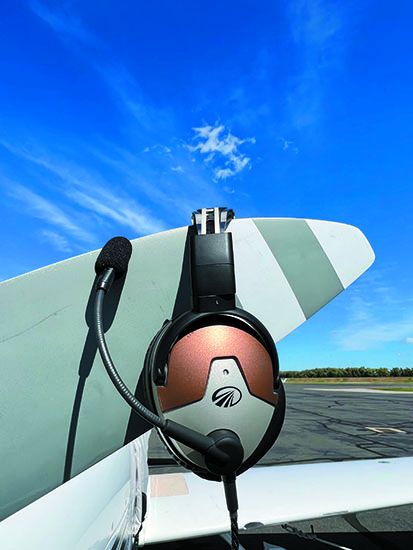Lightspeed knows its new $1099 Delta Zulu headset won’t appeal to all buyers, especially those needing a budget-priced set. Still, after spending some time with the feature-rich Delta Zulu, we think it hits enough high points to attract the attention of some buyers who might otherwise spend their money on a Bose A20. There’s a lot of appeal.
Lightspeed markets the set as a “safety wearable” because it has a built-in CO detector that integrates nicely with Lightspeed’s smartphone app. Plus, with a feature called HearingEQity, the Delta Zulu is also marketed to aging pilots who struggle with hearing loss. Here’s an overview of the new set that was announced this past September.
FIT AND FINISH
The Delta Zulu isn’t a refresh of the successful and good-performing $899 Zulu 3 ANR model, which will live on in the Lightspeed lineup, along with the $699 entry-level Sierra. Instead, Lightspeed gets credit for cranking out a fresh clean-sheet model at a time when few manufacturers are bringing anything new to the market no thanks to the choked supply chain.
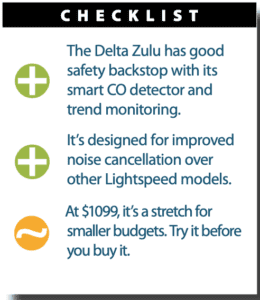
At 14.9 ounces (which is just slightly heavier than the Zulu 3), the set should offer a good, comfortable fit for the majority of wearers, although our caveat is the same as it is for any headset—try it first. We tried the set with and without a ballcap, with and without eyeglasses and even with a pair of Foggles view-limiting glasses and found it to be comfortable, although a couple of people commented that it had a slightly higher clamping force than the Bose A20 they are used to.
The set has a stainless steel headband that’s designed to follow the curve of the head for a better distribution of weight and side pressure. Overall, the Delta Zulu has a high-end feel as you would expect from a model at the top of the price category. Lightspeed worked on styling, too, and the headset’s outer ear cups have an attractive two-tone finish.
The ear seals are big, and the company said the goal was to design the cup cavities so that the entire ear fits comfortably inside, and so the ear seals efficiently hug the curve of the jaw for a natural fit. We think they got it right and that’s a good thing because the performance of any headset’s ANR circuitry depends on a good seal, especially when worn with eyeglasses.
What we really like about the Delta Zulu is the Kevlar-core-covered audio cables that promise long-term durability. The set’s dual-aperture disc microphone is easily adjustable and holds firmly where you put it. There’s nothing more annoying than a headset’s mic boom dropping out of position, but the boom on the Delta Zulu holds solid. There’s also a user-adjustable mic gain (under the mic’s windsock) to balance loud and soft voices in a multi-headset environment.
The Delta Zulu’s audio control module seems just the right size, and so are the audio cables. The upper cable (from the top of the control module to the headset) is 48 inches and the lower one is just over 21 inches. This makes it easy to stash the control module in an interior map pocket. Need something longer? Lightspeed said it can custom build it.
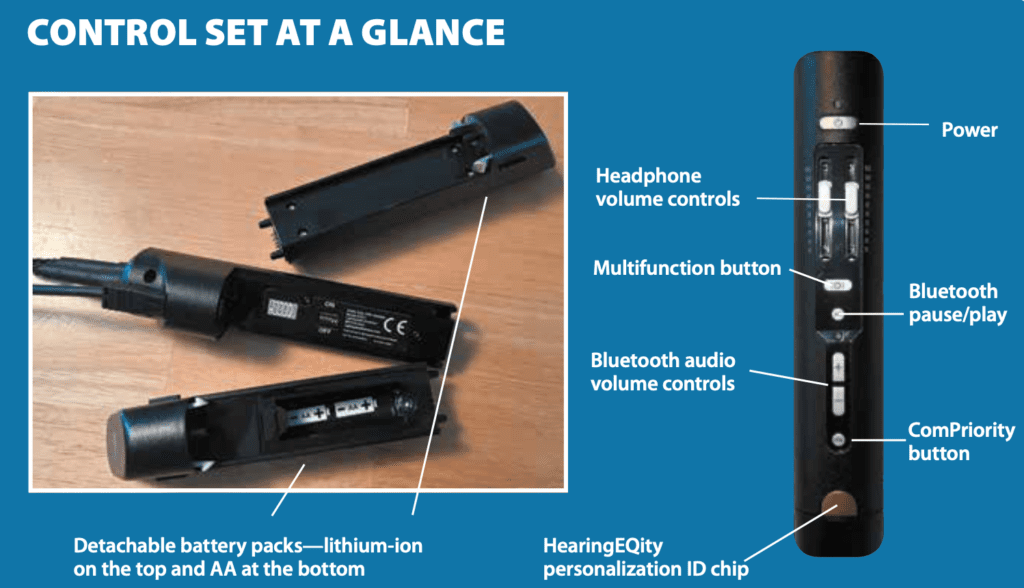
GOOD BATTERY SETUP
For powering the set, the Delta Zulu comes with a rechargeable lithium-ion battery pack that has roughly a 30-hour endurance. Another power option (it comes with the unit) is an interchangeable quick-release AA battery pack for 15-20 hours of endurance. The headset’s control module has a UAC (Universal Accessory Connector) for charging and data connections, and all Delta Zulu sets come standard with a USB-A to UAC cable (other cable options, including Lightning and USB-C, are available). The set can be recharged while it’s in use, and there’s a version with a 6-pin LEMO audio plug for connecting with ship’s power.
The battery cartridges slide on to the rear of the set’s control module and they are easy to swap out on the fly. If you forget to charge the lithium-ion pack (it can be charged in flight if you have a power bank or panel power port) and it goes flat in flight, keep the AA pack handy and you’ll be back in business. To save power, the headset will automatically power off approximately five minutes after it has been removed from the head. The power LED flashes red when batteries are low, but will operate for five more hours.
KANARY SMART ALERTS
We wonder just how many features are too many to build into a headset. After all, simplicity is important and the set has to be easy to use without having to flip through a user’s guide on the fly. But Lightspeed did a decent job of keeping the advanced functionality of the Delta Zulu reasonably easy to deal with, and it starts with the always-on carbon monoxide sensor that’s part of the set’s Kanary smart alert system.
This calibrated O2 sensor has a 10-year life (replaceable by Lightspeed) and is built into the left ear cup. The user sets their own timing for cautionary alerts (from five to 15 minutes), and for critical alerts, they come every two minutes and are unchangeable. You’ll hear audible alerting (“carbon monoxide unsafe level”) when the CO levels exceed the threshold. The adjustable low CO threshold (cautionary warning) is 10-50 ppm and the high threshold (critical warning) is 51-100 ppm. The warning alerts method can be set up in the Lightspeed app, and the alerts can be set up to provide voice only or a tone prior to the voice during alerts from the headset. Additionally, you can set the CO alerts to come through the headset’s left, right or both audio channels. The alerts are muted with the set’s multifunction button on the controller.
There’s also a cockpit voice recording feature that works along with the Lightspeed app. The app, when connected to the headset via Bluetooth, makes data available in real time (including CO trend monitoring), and has the recording function. The idea is to capture radio and intercom chatter for playback after the flight. There’s also instant playback of anything captured over the last two minutes, plus there’s a recording library within the app. The Lightspeed app is free and downloaded from the Apple iTunes store.
AUDIO EQ FEATURE
A major and first-of-a-kind feature on the Delta Zulu is the built-in electronic EQ utility called HearingEQity. The HearingEQity smart utility fine-tunes the headset’s audio signature to help compensate for a pilot’s hearing loss, which is first determined when the user puts on the headset and runs a 12-frequency hearing analysis for each ear. The results of this hearing profile—measured from 125 Hz to 12,000 Hz—are used by the Delta Zulu’s processor to automatically boost the audio levels in the appropriate frequency ranges. The audio profile can be repeated at any time, and the Lightspeed app (and your smartphone) is integral to setting up the feature and running the hearing test. Find a quiet spot to do the test—maybe climb in the airplane when it’s in a hangar.
Using the results of the hearing test, a user profile is created and stored in the headset. Once the profile is stored in the headset, the app does not need to be connected for HearingEQity to be active. Only one profile at a time can be stored, which leads to the dilemma of storing multiple Delta Zulu sets in the same cabin—which one is which? Lightspeed has a solution with a four-icon chip set for personalizing each headset. The color-coded chips replace the standard gold chip on the lower portion of the control module.
To replace the chip and personalize the headset, simply remove the battery module and locate the color chip at the bottom of the control’s surface. Using a fingernail or a small plastic screwdriver, pry up on the color chip, select the new color chip and center the color chip over the keyed hole in the control box and press it down until it’s flush.
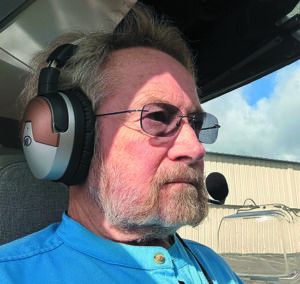
BLUETOOTH FUNCTIONS
The Delta Zulu has an A2DP Bluetooth transceiver for simultaneous cellphone communications, music streaming and tablet app audio input. The set’s ComPriority feature automatically lowers the volume of the input sources when there’s radio and intercom chatter. The soft mute feature gently eases music back in for a smooth listening transition.It’s automatically enabled at every power-up, but it can be turned off entirely with the Com button on the controller, and the user is alerted with an audio cue.
This feature has been standard in higher-end audio panels and intercoms for years, as we’ll as on other headsets. It’s useful if you listen to tunes in flight, whether wired or via Bluetooth. We learned that you’ll want to disable the ComPriority before making cellphone calls because the other party will be muted if it’s on.
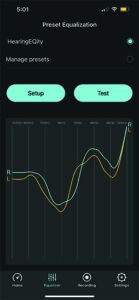
Worth mentioning is that the Kanari smart alert function operates independently of any auxiliary devices that are plugged in, either wirelessly or via Bluetooth. You can also plug a wired device into the UAC connector and that device will operate independently of devices connected via Bluetooth. There’s a lot of aux input potential for those who want to use it.
The multifunction or “smart” button on the controller is a dynamic control with a number of functions. A single press of the button mutes the CO alerts, double pressing toggles between the establish HearingEQity and turning it off and pressing and holding it forces Bluetooth pairing. The set automatically connects to the previously paired device at startup, and we found that the Bluetooth worked well. It never dropped a paired device and connection is quick.
BETTER ANR CIRCUITRY
Lightspeed says the Delta Zulu should offer the best noise canceling performance of any Zulu to date since it has redesigned feed-forward noise-canceling circuitry. In our limited use of an early-production/ beta model, we found the set’s ANR performance to be good—on par with what we’re accustomed to with a Bose A20. We didn’t hear any rumble or indications that the ANR circuitry was overworking.
Lightspeed says to maintain peak ANR performance and comfort, replace the ear seals, head pads and the mic muff every 18 months—something that we suspect many users don’t do. These items definitely wear out.
The company makes it more enticing because owners are automatically enrolled into the Lightspeed Wingman Club, and that provides them with a 30 percent discount on all accessories available for purchase on the Lightspeed website, including the replaceable soft goods.
As for Bluetooth and wired aux inputs, the stereo music quality piped in via Bluetooth from a new iPhone sounded quite good and there was enough audio gain for jamming out—something that’s often lacking in other models.
Speaking of stereo, there’s the usual caveat when using the set with stereo intercoms and audio panels installed with mono audio jacks. There’s a stereo/mono DIP switch located under the battery compartment in the controller. Lightspeed ships all headsets with the DIP switch in mono, but some users wrongly switch it to stereo when they have a stereo intercom, including models from PS Engineering and Garmin. The trouble comes when you plug into the headphone jack because one channel shorts out and you’ll either get audio in just one ear or weak audio in both ears. Ask your avionics installer if they are installing mono or stereo jacks during audio panel retrofits.
Worth mentioning is that the stereo/mono DIP switch does not affect auxiliary music devices, so you can still listen to auxiliary audio in stereo regardless of how the switch is set.
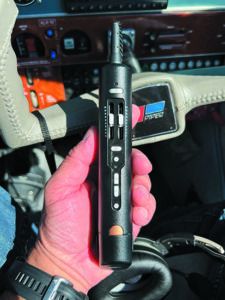
WHO WILL BUY IT?
That’s precisely what we asked Lightspeed’s Teresa De Mers, who reiterated that the Delta Zulu won’t replace the Zulu 3. According to De Mers, the Delta Zulu should appeal to buyers who are concerned with carbon monoxide in the cabin and for pilots (and passengers) who believe they suffer from hearing loss. Face it, with the aging pilot population, that could be a lot of sales. On the other hand, we wonder if the HearingEQity will make that much of a difference, especially for those who wear hearing aids. While Lightspeed said the Delta Zulu might work with the hearing aids in (but to try simply try it), our preliminary trials proved that it does not, at least for two people who tried the set. That’s pretty consistent with our findings when we wrote about hearing aids for pilots in the March 2021 Aviation Consumer.
As Dr. Brian Peck—a hearing aid wearer who flies a Piper Saratoga and Piper Cub (and removes them for flying)—put it, “The headset is actually your hearing aid,” and we can’t disagree. A good headset (and a high-quality audio panel installed correctly) should provide flawless, natural audio made better by a good-fitting ear cup surrounding the ears.
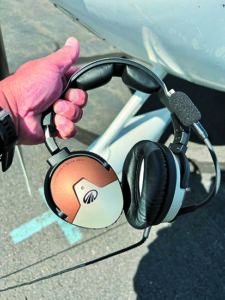
At this point we can’t say if Lightspeed’s HearingEQuity will make enough of a difference for those with hearing problems, but we can’t see how the utility can be a hindrance. We have several evaluators (who wear hearing aids) flying with the Delta Zulu and we’ll report back in a few months with a long-term report, including the results of a performance shootout with the Bose A20.
For now, we think Lightspeed’s Delta Zulu is welcomed competition in the over-$1000 headset market, which until now was only occupied by Bose. The built-in CO detector, audio recorder and advanced Bluetooth make it an impressive set that will steal some buyers from the competition.
Visit www.lightspeedaviation.com.

